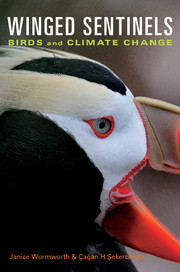Book contents
- Frontmatter
- CONTENTS
- ACKNOWLEDGEMENTS
- Introduction: The Free Advice of Birds
- Chapter 1 Phenology: Seasonal Timing and Mismatch
- Chapter 2 Migratory Birds Face Climate Turbulence
- Chapter 3 Range Shifts and Reshuffled Communities
- Chapter 4 Seabirds Herald Ocean Changes
- Chapter 5 Climate Change, Abundance and Extinction
- Chapter 6 Tropical Warming and Habitat Islands
- Chapter 7 Shifting Ground on Conservation
- NOTES
- INDEX
- PLATE SECTION
- PLATE SECTION
- PLATE SECTION
Chapter 7 - Shifting Ground on Conservation
Published online by Cambridge University Press: 05 March 2012
- Frontmatter
- CONTENTS
- ACKNOWLEDGEMENTS
- Introduction: The Free Advice of Birds
- Chapter 1 Phenology: Seasonal Timing and Mismatch
- Chapter 2 Migratory Birds Face Climate Turbulence
- Chapter 3 Range Shifts and Reshuffled Communities
- Chapter 4 Seabirds Herald Ocean Changes
- Chapter 5 Climate Change, Abundance and Extinction
- Chapter 6 Tropical Warming and Habitat Islands
- Chapter 7 Shifting Ground on Conservation
- NOTES
- INDEX
- PLATE SECTION
- PLATE SECTION
- PLATE SECTION
Summary
Assesing birds‘ capacity to adapt to climate change
In a changed Everglades, more alteration looms
Rising sea levels are erasing familiar boundaries. In fact, conservationists may find themselves fighting for lands that will soon be under water.
Conservation Magazine, 2009The evolving story of the Everglades in Florida, USA illustrates the difficult choices conservationists may face as global warming drives change and breeds uncertainty. In former times, Lake Okeechobee overflowed its banks during the annual wet season, feeding a vast, shallow sheet of fresh water that ambled slowly seawards for about 160 kilometres. In some areas the wetlands it created were almost as broad as the Florida peninsula itself. Lying at the confluence of temperate and subtropical realms, they still host explosive bird diversity. Pink-bodied roseate spoonbills, Platalea ajaja, snowy egrets, Egretta thula, and rare and endangered wood storks, Mycteria americana, are among the more than 350 species counted in the Everglades. This is, in fact, North America's most significant breeding ground for wading birds.
‘They were changeless. They are changed,’ wrote Marjory Stoneman Douglas, who dedicated her life to trying preserve the Everglades. Change began with flood control efforts in 1882, and over the next century this timeless ‘river of grass’ was reduced by half, its marshlands drained for agriculture and development. Although John James Audubon had once described flocks of waders so great they could ‘actually block out the light from the sun for some time’, bird abundance has plummeted by 90 per cent.
- Type
- Chapter
- Information
- Winged SentinelsBirds and Climate Change, pp. 193 - 227Publisher: Cambridge University PressPrint publication year: 2011

